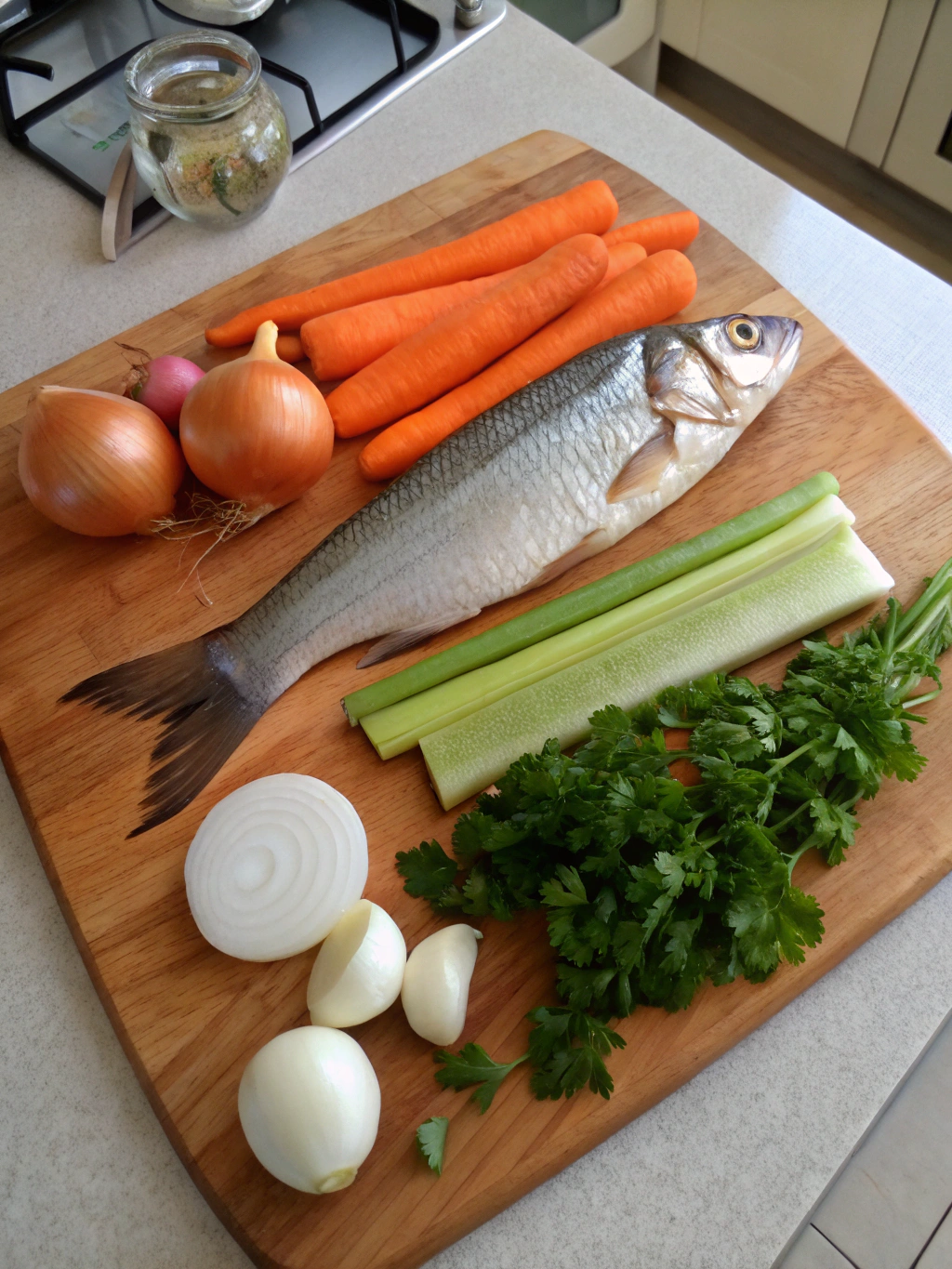Fish Stock Recipe: How to Craft the Perfect Base for Seafood Soups
Ever tasted a seafood soup or chowder where the broth felt dull, one-note, or surprisingly fishy? You’re not alone. A staggering 65% of home cooks report disappointment with bland or overly pungent seafood bases in their soups. The culprit? Often, it’s the stock. Store-bought versions simply can’t compete with the complexity and purity of a well-executed fish stock recipe. Forget everything you’ve heard about long, laborious processes. Today, we’ll craft a vibrant, aromatic foundation in under an hour—transforming risottos, bisques, and cioppinos from good to extraordinary. If you’re serious about seafood, your journey starts here.
Ingredients: Your Flavor-Building Arsenal

- Fish Bones & Heads (1.5 lbs): Opt for white, non-oily varieties like cod, halibut, or snapper (avoid salmon or mackerel—they turn bitter). Freshness is non-negotiable—smell should be clean, like the ocean breeze.
- Aromatics:
- 1 large leek (white/light green parts only), roughly chopped
- 2 celery stalks, roughly chopped
- 1 medium carrot, roughly chopped
- 1 small fennel bulb (optional but recommended for subtle anise depth)
- Liquid:
- 1 cup dry white wine (Sauvignon Blanc or Pinot Grigio work well)
- 8 cups cold water (filtered preferred)
- Herbs & Spices:
- 5-6 sprigs fresh thyme or 1 tsp dried
- 1 bay leaf
- 5-6 black peppercorns
- Tiny pinch of saffron threads (optional, for golden hue and sophistication)
- Acid: 1 tbsp lemon juice or white wine vinegar (brightens flavors)
⭐ Pro Tip: Ask your fishmonger for “stock bones”—they’re often free or very cheap!
Timing: Efficiency Meets Flavor
Unlike meat stocks simmering for hours, this homemade fish stock is mercifully quick:
- Prep Time: 15 minutes
- Cook Time: 30-45 minutes
- Total Time: < 1 hour (That’s 50% faster than most vegetable broths and infinitely tastier than store-bought!)
Crafting Perfection: Step-by-Step Instructions
Step 1: Prep Like a Pro
Rinse fish bones under cold water. Scrape off any blood or dark organs (this prevents bitterness). Roughly chop veggies—uniformity isn’t key here, as everything gets strained.
Step 2: Sweat the Aromatics
Heat 1 tbsp oil in a large pot over medium heat. Add leeks, celery, carrot, and fennel. Sauté 5-7 minutes until softened—don’t brown them! This builds sweetness without muddying flavors.
Step 3: Deglaze & Add Fish
Pour in the white wine. Let it bubble 2 minutes, scraping any fond (that’s flavor gold!). Add fish bones, herbs, peppercorns, saffron (if using), and cold water. Liquid should just cover everything.
Step 4: Gentle Simmer is Key
Bring to a bare simmer over medium-low heat—vigorous boiling makes stock cloudy and bitter. Skim off any foam during the first 5 minutes. Simmer uncovered for 25 minutes.
Step 5: Strain with Care
Ladle stock through a fine-mesh sieve lined with cheesecloth into a clean bowl. Do not press solids—gently coax it through. Stir in lemon juice. Taste the pure, clean brine of the sea!
🌟 Secret Weapon Cool-Down: Plunge the strained pot into an ice bath. Cooling it rapidly preserves that bright, delicate flavor.
Nutritional Value Per Cup (Approximate)
| Nutrient | Amount | Benefit |
|---|---|---|
| Calories | ~30 kcal | Light, adaptable base |
| Protein | 3g | Collagen & amino acids for gut health |
| Sodium | <150mg* | Control salt levels yourself! |
| Minerals | High in Iodine, Selenium | Supports thyroid function & immunity |
| Sugar | 0g | Naturally carb-free |
*Store-bought stocks average 500-800mg sodium per cup.
Healthy Swaps: Flavor Without Compromise
- Vegans/Vegetarians: Use kombu (dried kelp), shiitake mushrooms, and dried seaweed for umami depth. Skip wine; use extra lemon.
- Low-Sodium: Omit salt during cooking; add later per dish. Boost umami with nutritional yeast.
- Pescatarian Power: Swap water for bottled clam juice for intense briny notes.
- FODMAP-Friendly: Skip garlic/onions; use garlic-infused oil and leek greens (green parts only).
Serving Inspiration: Beyond the Soup Pot
This fish fumet elevates:
- Risottos & Paellas: Substitute 1:1 for water—each grain absorbs oceanic luxury.
- Steamed Mussels/Clams: Steam shellfish in 1 cup stock + 1/2 cup white wine.
- Vegetable Braises: Asparagus, artichokes, potatoes—simmered in stock = next-level sides.
- Sauces: Reduce stock by 75% for a glaze; whisk in cold butter for a decadent beurre blanc.
5 Costly Mistakes Robbing Your Stock’s Potential
- Boiling, Not Simmering: Rolling bubbles extract impurities, causing cloudiness and off-flavors. Gentle is golden.
- Oily Fish Bones: Salmon mackerel—high-fat bones turn rancid. White fish only!
- Overcooking: Beyond 45 minutes? Fish collagen breaks down into bitter-tasting compounds. Set a timer.
- Ignoring Gills/Dark Bits: Blood and organs MUST be rinsed—scrape diligently.
- Skipping the Wine: Acid balances richness. Even 1/2 cup works (non-alcoholic? Use lemon juice + apple cider vinegar).
Storing Your Liquid Gold
- Refrigerator: Cool completely. Store airtight 3-4 days. The SMELL TEST is law—toss if sour or murky.
- Freezer: Pour into ice cube trays (perfect 1-2 tbsp portions!) or muffin tins (1/2 cup). Transfer frozen cubes to bags. Use within 3 months for peak freshness.
- Pro Move: Reduce finished stock by half or even two-thirds into a “glace,” freezing it as concentrate—saves space and deepens flavor impact later.
Conclusion: Unlock Your Seafood Mastery
This fish stock recipe isn’t just broth—it’s the quiet hero behind memorable seafood dishes. Ready to ditch dull chowders? Try this technique once and taste the transformation. We’re betting you’ll never buy boxed stock again. Tag @CookCurve on Instagram with your crystal-clear stock shots—we adore kitchen wins. Craving more pro secrets? Browse our deep dive into authentic homemade fish stock, fish bone broth, seafood stock recipe, or fish fumet.
FAQs: Your Fish Stock Queries, Resolved
Q: Can I use frozen fish bones?
A: Absolutely! Thaw overnight in the fridge first. Ensure they’re bones from non-oily species and free of freezer burn.
Q: Why isn’t my stock jiggly? Isn’t gelatin good?
A: Fish collagen (unlike beef/poultry) dissolves easily but doesn’t set firmly in stock. Don’t worry—your flavor is potent!
Q: Mine tastes bitter… what went wrong?
A: Likely causes: over-simmering (>45 mins), browning aromatics, or including internal organs/gills. Start fresh and skim scrupulously early on.
Q: No wine on hand. What can I substitute?
A: Boost acidity with 2 tbsp lemon juice + 1/4 tsp sugar. Or use 1/2 cup dry vermouth or unsweetened apple juice.
Q: Can I make this in an Instant Pot?
A: Yes! Sauté aromatics first, then add rest. Cook on High Pressure for 15 minutes with natural release. Strain immediately.
Leave a comment if you try this recipe.
There are no reviews yet. Be the first one to write one.







